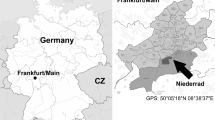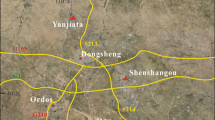Abstract
On the background of the phylogeny of the Papaveraceae s.l., the evolution of the androecium and gynoecium, the geographical distribution, and the ecological differentiation of the family is discussed. An effort is made to homologize the diverse androecia of Pteridophyllum, Hypecoum, Fumariaceae and Papaveraceae s.str., and it is concluded that both the polyandrous androecium as found in the Papaveraceae s.str. and the polycarpellate gynoecium as found in Papaveraceae s. str. subfam. Papaveroideae incl. Platystemonoideae are secondary and derived from whorled oligomerous androecia and bicarpellate gynoecia, respectively. The comparative consideration of the geographical distribution, ecology and diversity of various monophyletic units within the family suggests (1) that forest floor habitats might be ancestral in the family, (2) that in parts of the family generic diversification preceded the break-up of the northern continents, and (3) that aridification of the environment was a major stimulus for both diversification and morphological divergence in the family.
Access this chapter
Tax calculation will be finalised at checkout
Purchases are for personal use only
Preview
Unable to display preview. Download preview PDF.
Similar content being viewed by others
References
Arber, A., 1932: Studies in floral morphology. IV. On the Hypecoideae, with special reference to the androecium. — New Phytol. 31: 145–173.
Blattner, F. R., Kadereit, J. W., 1995: Three intercontinental disjunctions in Papaveraceae subfam. Chelidonioideae: evidence from chloroplast DNA. — Pl. Syst. Evol. [Suppl.] 9: 147–157.
Boufford, D. E., Spongberg, S. A., 1983: Eastern Asian — eastern North American phytogeographical relationships — a history from the time of Linnaeus to the twentieth century. — Ann. Missouri Bot. Gard. 70: 423–439.
Brückner, C., 1982: Zur Kenntnis der Fruchtmorphologie der Papaveraceae Juss. s.str. und der Hypecoaceae (Prantl & Kündig) Nak — Feddes Repert. 93: 153–212.
— 1983: Zur Morphologie der Samenschale in den Papaveraceae Juss. s.str. und Hypecoaceae (Prantl & Kündig) Nak. — Feddes Repert. 94: 361–405.
— 1985: Frucht-und Samenanatomie von Pteridophyllum racemosum Sieb. et Zucc., und die Position der monotypischen Gattung in den Papaverales. — Feddes Repert. 96: 199–213.
Buchenau, F., 1866: Bemerkungen über den Blüthenbau der Fumariaceen und Cruciferen.-Flora 49: 39–46.
Burtt, B. L., 1971: From the South: an African view of the floras of Western Asia. — In Davis, P. H., Harper, P. C., Hedge, I. C., (Eds): Plant life of South-West Asia, pp. 135–149. — Edinburgh: The Botanical Society of Edinburgh.
Celakovsky, L. J., 1894: Das Reductionsgesetz der Blüten. — Sitzungsber. Böhm. Ges. Math. Naturwiss. 150: 1–142.
Dahl, A. E., 1990: Infrageneric division of the genus Hypecoum L. (Papaveraceae). — Nordic J. Bot. 10: 129–140.
Eichler, A. W., 1865: Über den Blüthenbau der Fumariaceen, Cruciferen und einiger Capparideen. — Flora 48: 433–444, 449–460.
Endress, P. K., 1987: Floral phyllotaxis and floral evolution. — Bot. Jahrb. Syst. 108: 417–438.
— 1995: Floral structure and evolution in Ranunculanae. — Pl. Syst. Evol. [Suppl.] 9: 47–61.
Erbar, C., Leins, P., 1981: Zur Spirale in Magnolien-Blüten. — Beitr. Biol. Pfl. 56: 225–241.
— 1983: Zur Sequenz von Blütenorganen bei einigen Magnoliiden. — Bot. Jahrb. Syst. 105: 379–400.
Ernst, W. R., 1962: A comparative morphology of the Papaveraceae. — Unpublished Ph.D. Dissertation, Stanford University.
Fedde, F., 1905: Die geographische Verbreitung der Papaveraceae. — Englers Bot. Jahrb. 36, Beiblatt 81: 28–43.
— 1909: Papaveraceae-Hypecoideae et Papaveraceae-Papaveroideae. — In Engler, A. (Ed.): Das Pflanzenreich IV, 104, pp. 1–430. — Leipzig: Engelmann.
— 1936: Papaveraceae. — In Engler, A., Harms, H. (Eds): Die natürlichen Pflanzenfamilien 17b, 2nd edn., pp. 5–145. — Leipzig: Engelmann.
Friedel, J., 1938: Note sur la Structure anatomique du Pteridophyllum racemosum Sieb. et Zucc. — Bull. Soc. Bot. France 85: 406–408.
Günther, K.-F., 1975a: Beiträge zur Morphologie und Verbreitung der Papaveraceae. 1. Teil: Infloreszenzmorphologie der Papaveraceae; Wuchsformen der Chelidonieae. — Flora 164: 185–234.
— 1975b: Beiträge zur Morphologie und Verbreitung der Papaveraceae. 2. Teil: Die Wuchsformen der Papaveraceae, Eschscholzieae und Platystemonoideae. — Flora 164: 393–436.
Hong, De-Yuan, 1993: Eastern Asian North American disjunctions and their biological significance. — Cathaya 5: 1–39.
Hoot, S., Crane, P., 1995: Inter-familial relationships in the Ranunculidae based on molecular systematics. — Pl. Syst. Evol. [Suppl.] 9: 119–131.
Hutchinson, J., 1921: The genera of Fumariaceae and their distribution. — Bull. Misc. Inf., Royal Bot. Gardens, Kew 3: 97–115.
Jork, K. B., Kadereit, J. W., 1995: Molecular phylogeny of the Old World representatives of Papaveraceae subfam. Papaveroideae with special emphasis on the genus Meconopsis — Pl. Syst. Evol. [Suppl.] 9: 171–180.
Kadereit, J. W., 1988: Sectional affinities and geographical distribution in the genus Papaver L. (Papaveraceae). — Beitr. Biol. Pfl. 63: 139–156.
— 1993: Papaveraceae. — In Kubitzki, K., (Ed): The families and genera of vascular plants 2, pp. 494–506. — Heidelberg: Springer.
— Blattner, F. R., Jork, K., Schwarzbach, A., 1994: Phylogenetic analysis of the Papaveraceae s.l. (incl. Fumariaceae, Hypecoaceae, and Pteridophyllum) based on morphological characters. — Bot. Jahrb. Syst. 116: 361–390.
Karrer, A. B., 1991: Blütenentwicklung und systematische Stellung der Papaveraceae und Capparaceae. — Unpublished Ph.D. Dissertation, University of Zürich.
Layka, S., 1976: Les methodes modernes de la palynologie appliquées a l’étude des Papaverales. — Unpublished Dissertation, University of Montpellier.
Léger, L. J., 1894: Recherches sur l’appareil végétatif des Papavéracées (Papavéracées et Fumariacées D. C.). — Mém. Soc. Linn. Normandie 18: 195–623.
Lehminger, R., 1985: Entwicklungsgeschichtliche Untersuchungen an Fumariaceen-Blüten. — Unpublished Diplomarbeit, University of Bonn.
— Leins, P., 1985: Besonderheiten in der Entwicklungsgeschichte einiger Fumariaceen-Blüten. — In Ehrendorfer, F., (Ed.): 8. Symposium Morphologie, Anatomie und Systematik. Zusammenfassungen; 58.
Leins, P., Erbar, C., 1985: Ein Beitrag zur Blütenentwicklung der Aristolochiaceae, einer Vermittlergruppe zu den Monokotylen. — Bot. Jahrb. Syst. 107: 343–368.
— 1991: Entwicklungsmuster in Blüten und ihre mutmaβlichen phylogenetischen Zusammenhänge. — Biol. Unserer Zeit 21: 197–204.
Lidén, M., 1986: Synopsis of Fumarioideae (Papaveraceae) with a monograph of the tribe Fumarieae. — Opera Bot. 88: 1–133.
— 1993a: Pteridophyllaceae. — In Kubitzki, K., (Ed.): The families and genera of vascular plants 2, pp. 556–557. — Heidelberg: Springer.
— 1993b: Fumariaceae. — In Kubitzki, K., (Ed): The families and genera of vascular plants 2, pp. 310–318. — Heidelberg: Springer.
Mair, O., 1977: Zur Entwicklungsgeschichte monosymmetrischer Dicotylen-Blüten.-Dissertationes Botanicae 38: 1–88.
Merxmuller, H., Leins, P., 1967: Die Verwandtschaftsbeziehungen der Kreuzblütler und Mohngewächse. — Bot. Jahrb. Syst. 86: 113–129.
Meusel, H., 1969: Beziehungen in der Florendifferenzierung von Eurasien und Nordamerika. — Flora 158: 537–564.
Murbeck, S., 1912: Untersuchungen über den Blütenbau der Papaveraceen. — Kongl. Svenska Vetensk. Acad. Handl. 50: 1–168.
Payer, J. B., 1857: Traité d’organogénie comparée de la fleur. — Paris: V. Masson.
Raven, P. H., 1972: Plant species disjunctions: a summary. — Ann. Missouri Bot. Gard. 59: 234–246.
— Axelrod, D. I., 1974: Angiosperm biogeography and past continental movements. — Ann. Missouri Bot. Gard. 61: 539–673.
Ronse Decraene, L. P., Smets, E. F., 1990: The systematic relationship between Begoniaceae and Papaveraceae: a comparative study of floral development. — Bull. Jard. Bot. Belg. 60: 229–273.
— 1992a: An updated interpretation of the androecium of the Fumariaceae. — Canad. J. Bot. 70: 1765–1776.
— 1992b: Complex polyandry in the Magnoliatae: definition, distribution and systematic value. — Nordic J. Bot. 12: 621–649.
Ryberg, M., 1960: A morphological study of Fumariaceae and the taxonomical significance of the characters examined. — Acta Horti Bergiani 19: 121–248.
Schwarzbach, A., Kadereit, J. W., 1995: Rapid radiation of North American desert genera of the Papaveraceae: evidence from restriction site mapping of PCR-amplified chloroplast DNA fragments. — Pl. Syst. Evol. [Suppl.] 9: 159–170.
Stern, K. R., 1961: Revision of Dicentra. — Brittonia 13: 1–52.
Vent, W., Mory, B., 1973: Beiträge zur Kenntnis der Sippenstruktur der Gattungen Glaucium Adans. und Dicranostigma Hooker. & Thomson (Papaveraceae). — Gleditschia 1: 33–41.
Wu, Zhenyi, 1983: On the significance of Pacific intercontinental discontinuity. — Ann. Missouri Bot. Gard. 70: 577–590.
Zhuang, Xuan, 1993: The taxonomic and evolution and distribution of Papaveraceae.-Acta Bot. Yunnanica 15: 137–148.
Author information
Authors and Affiliations
Editor information
Editors and Affiliations
Rights and permissions
Copyright information
© 1995 Springer-Verlag Wien
About this paper
Cite this paper
Kadereit, J.W., Blattner, F.R., Jork, K.B., Schwarzbach, A. (1995). The phylogeny of the Papaveraceae sensu lato: morphological, geographical and ecological implications. In: Jensen, U., Kadereit, J.W. (eds) Systematics and Evolution of the Ranunculiflorae. Plant Systematics and Evolution Supplement 9, vol 9. Springer, Vienna. https://doi.org/10.1007/978-3-7091-6612-3_12
Download citation
DOI: https://doi.org/10.1007/978-3-7091-6612-3_12
Publisher Name: Springer, Vienna
Print ISBN: 978-3-7091-7361-9
Online ISBN: 978-3-7091-6612-3
eBook Packages: Springer Book Archive




